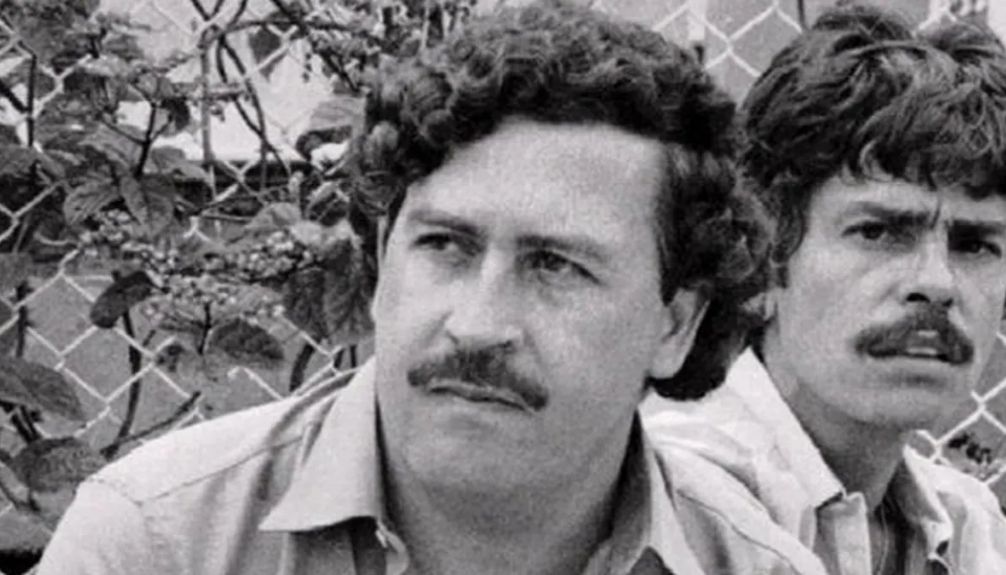In the domain of illicit riches, Pablo Escobar‘s net worth soared to a staggering $30 billion, outshining other drug lords globally. His empire burgeoned through calculated partnerships, violence, and corruption, affording him control of 80% of the cocaine market, with daily smuggles of over 15 tons to the US. Escobar, culminating in a demise marked by Colombian forces in 1993, left a void in the criminal world. Of particular interest are his intricate cash hideouts, like the Hacienda Nápoles, revealing millions in concealed wealth. Behind the facade of unprecedented opulence lies a legacy enthralling masses in diverse forms, hinting at a riveting narrative awaiting discovery.
Pablo Escobars Early Life and Rise
Pablo Escobar’s early life in Colombia set the foundation for his eventual rise as a notorious criminal figure. Born in Rionegro in 1949, Escobar’s involvement in criminal activities began during his teenage years. Even though he briefly attended Universidad Autonoma Latinoamericana, his criminal career took off when he earned $100,000 from a kidnapping. Escobar, the third of seven children, quickly shifted from small-scale criminal activities to more serious offenses like drug trafficking and organized crime.
His ruthless tactics and strategic maneuvers in the drug trade propelled his rise to power and wealth as a Colombian drug lord. Escobar’s calculated moves and dominance in the market solidified his position, making him a formidable force in the world of organized crime.
From humble beginnings to becoming one of the most infamous figures in history, Escobar’s early choices and actions paved the way for his eventual notoriety and influence in the criminal underworld.
Escobars Criminal Empire Expansion
Pablo Escobar’s criminal empire saw rapid growth through strategic expansion methods, influential partnerships, and the scaling up of illegal operations. His calculated approach to empire-building enabled him to control a significant portion of the global cocaine market and amass immense profits.
The Medellin Cartel, under Escobar’s leadership, solidified its dominance by distributing a substantial share of the world’s cocaine supply.
Empire Growth Strategies
Escobar’s criminal empire expanded rapidly through strategic alliances with other drug traffickers, utilizing violence and intimidation to eliminate rivals and secure control over key drug routes. His empire growth strategies included corrupting officials and law enforcement to protect his operations. To paint a clearer picture, let’s look at the key elements of Escobar’s criminal empire growth in the table below:
| Key Elements | Description |
|---|---|
| Strategic Alliances | Collaborated with other traffickers to expand influence and market reach |
| Violent Tactics | Used violence and intimidation to eliminate competition and maintain power |
| Distribution Network | Established a vast network across multiple countries for drug distribution |
| Corruption | Engaged in corrupt practices to shield operations from legal interventions |
| Drug Sales | Generated massive profits from cocaine sales in the US and globally |
Influential Business Partnerships
Establishing influential partnerships with key players in the drug trade greatly fueled the expansion of Escobar’s criminal empire. Collaborating with the Ochoa brothers and Carlos Lehder boosted drug production, distribution, and profits to unprecedented levels.
This strategic alliance not only enabled Escobar to control a substantial share of the global cocaine market but also solidified the Medellin Cartel‘s dominance, especially in the United States.
Through these partnerships, Escobar’s criminal network flourished, reaching new heights of power and wealth. The synergies created by working with these influential figures allowed for a more efficient and effective operation, leading to significant growth and influence within the illicit drug trade.
Illegal Operations Expansion
Rapidly expanding his criminal empire, Pablo Escobar’s illegal operations became synonymous with dominating the global cocaine market. Controlling 80% of the market, Escobar’s empire smuggled over 15 tons of cocaine daily into the US through intricate smuggling routes. This illicit activity resulted in an estimated $420 million in weekly revenue, solidifying Escobar’s position as one of the richest drug lords in history. However, this expansion was marred by a trail of violent crimes, with Escobar being linked to thousands of murders. Despite the immense wealth generated, Escobar’s criminal empire faced constant scrutiny and opposition from law enforcement agencies globally.
| Keywords | Facts |
|---|---|
| Illegal Operations Expansion | Controlled 80% of global cocaine market |
| Global Cocaine Market | Smuggled over 15 tons of cocaine daily into the US |
| Smuggling Routes | Generated an estimated $420 million in weekly revenue |
| Weekly Revenue | Linked to thousands of murders and violent crimes |
| Violent Crimes | Wealth peaked at around $30 billion |
Pablo Escobars Net Worth Accumulation
During his notorious reign in the drug trade, Pablo Escobar‘s net worth skyrocketed to a peak of $30 billion through his expansive drug empire.
As the leader of the Medellin Drug Cartel, Escobar amassed immense wealth through his cocaine empire, controlling a staggering 80% of the global cocaine market.
His organization raked in over $70 million daily at its peak, with an astonishing operation that smuggled 15 tonnes of drugs into the US every day.
The Colombian government, rival cartels, and even Escobar’s own family laid claim to his wealth after his death, sparking numerous disputes over the vast fortune he’d accumulated.
Even after his demise, Escobar’s hidden riches still surface, with discoveries like $600 million in 2015 and $18 million in 2020, showcasing the immense scale of his wealth accumulation and the ongoing saga surrounding the legacy of this infamous drug lord.
The Reign of Terror: Escobars Dominance
Pablo Escobar’s reign of terror was characterized by violent control tactics and the expansion of his criminal empire. His ruthless approach to maintaining dominance in the global cocaine market led to thousands of deaths, including those of key figures who dared to oppose him.
Escobar’s grip on power was solidified by his massive drug profits and an intricate network of smuggling operations.
Violent Control Tactics
Escobar’s violent reign of terror, marked by thousands of murders and brutal enforcement tactics, exemplified his dominance in the criminal underworld. Through the Medellin Cartel, he employed violent control tactics, including bombings, assassinations, and ruthless methods to maintain his criminal empire’s grip.
The fear he instilled enabled his drug operations to thrive, solidifying his power and wealth. Escobar’s reign of terror was a brutal showcase of his dominance in the drug trade, leaving a trail of devastation in his wake.
The ruthless enforcement of his rule highlighted the harsh reality of operating within his empire, where violence and fear were the norm.
Criminal Empire Expansion
At the peak of his power, the Medellin Cartel, under Escobar’s leadership, wielded unprecedented control over the global cocaine market. Escobar’s criminal empire expanded rapidly, solidifying his dominance in the drug trade. He orchestrated a sophisticated smuggling network that funneled over 15 tons of cocaine into the US daily, showcasing the vast reach of his operations. This expansion was fueled by Escobar’s willingness to resort to extreme measures, including thousands of murders, to maintain his grip on power. Despite the brutality of his tactics, Escobar’s criminal enterprise flourished, allowing him to amass a staggering peak net worth of $30 billion. The extent of his influence and control over the cocaine market was unparalleled, marking a dark chapter in the history of organized crime.
| Aspect | Details |
|---|---|
| Expansion | Rapid growth of empire |
| Dominance | Control of global market |
| Smuggling | 15 tons of cocaine daily |
Escobars Wealth Management and Assets
Managing his immense fortune, Escobar strategically stashed cash in various locations to conceal his wealth. His assets included properties such as Hacienda Nápoles, La Catedral, and La Manuela, which have now been transformed into tourist attractions.
Escobar’s intricate methods of hiding cash in walls and secret compartments led to continuous discoveries of his hidden funds. Remarkable findings related to his wealth management include the detection of $600 million in 2015 and $18 million in 2020.
The TV series ‘Finding Escobar’s Millions‘ was dedicated to uncovering any remaining concealed funds associated with Escobar’s empire. The ongoing revelations of Escobar’s hidden wealth continue to intrigue and captivate many, shedding light on the elaborate schemes employed by the notorious drug lord to safeguard his immense riches.
Personal Life and Family of Escobar
Pablo Escobar’s personal life and family background played a significant role in shaping the lives of his relatives.
His wife, Maria Victoria Henao, and their children, Juan and Manuela, have all taken different paths in their careers, with Juan, now known as Marroquin, pursuing architecture in Argentina.
The influence of Escobar’s legacy can be seen in the successful endeavors of his family members, each carving their own paths despite their connection to one of history’s most notorious figures.
Family Background of Escobar
Born in 1949 in Rionegro, Colombia, Pablo Escobar emerged from humble beginnings as the son of a struggling farmer, setting the stage for his notorious criminal career.
Escobar’s impoverished upbringing played a significant role in his early involvement in criminal activities. Growing up in a challenging environment, he was the third of seven children in his family.
Escobar’s criminal journey began in his teenage years, leading him to engage in various illegal enterprises. Despite briefly attending Universidad Autonoma Latinoamericana, he quickly turned to more lucrative but illicit activities.
Remarkably, Escobar’s criminal inclinations were evident when he earned $100,000 from a kidnapping, showcasing his early willingness to partake in nefarious deeds that would later define his infamous drug lord status.
Influence on Relatives
Emerging from the shadow of Pablo Escobar’s notorious legacy, his family members have navigated a complex journey shaped by both his criminal empire’s remnants and their own individual pursuits. Pablo Escobar’s son, Sebastián Marroquin, pursued a career as an architect in Argentina after changing his name. Meanwhile, Maria Victoria Henao, Escobar’s wife, shifted into a designer and businesswoman with an estimated net worth of $30 million. However, internal conflicts arose within Escobar’s family as they tried to sustain their lifestyle on the limited remaining money after Escobar’s death. These internal disputes were fueled by the financial constraints left by Escobar’s demise, impacting the family’s lifestyle and future considerably.
| Family Member | Pursuit |
|---|---|
| Sebastián Marroquin | Architect in Argentina |
| Maria Victoria Henao | Designer and Businesswoman |
Escobars Downfall and Death
After being on the run for months, Colombian policemen fatally shot Pablo Escobar in 1993, marking the end of his reign as the notorious drug lord of the Medellin Cartel.
Escobar’s downfall culminated in his death, which brought an end to his control over the cocaine trade and criminal empire he’d meticulously built. The Colombian government viewed Escobar’s demise as a victory in the ongoing battle against drugs and organized crime. His death was a pivotal moment in Colombia’s history, symbolizing the downfall of a powerful and ruthless criminal figure who’d instilled fear and chaos for years.
The event was met with mixed reactions, with some celebrating the end of Escobar’s reign, while others mourned the loss of life and the impact of his criminal activities. Escobar’s death left a significant void in the criminal underworld, reshaping the landscape of illicit activities in Colombia.
Pablo Escobars Legacy in Pop Culture
Pablo Escobar’s enduring legacy in pop culture is marked by a proliferation of books, documentaries, TV series, and various artistic representations dedicated to his notorious life and criminal empire. His influence extends beyond his criminal activities, encompassing his wealth, power, and iconic status. The Medellin Drug Cartel, led by Escobar, has been a central theme in many films and documentaries, shedding light on the rise and fall of one of the most infamous drug lords in history.
To explore the multifaceted impact of Pablo Escobar on pop culture, let’s delve into a table showcasing the various forms through which his legacy persists:
| Form of Media | Description | Example |
|---|---|---|
| TV Series | Dramatic portrayals of Escobar’s life and crimes | ‘Narcos’ |
| Books | In-depth explorations of Escobar’s criminal empire | ‘Killing Pablo’ |
| Artistic Representations | Creative interpretations of Escobar’s image and influence | Graffiti murals in urban areas |
| Merchandise | Consumer products featuring Escobar’s likeness | T-shirts, posters, and memorabilia |
| Fashion | Clothing lines inspired by Escobar’s style | ‘Narcos’ themed apparel |
Through these mediums, Pablo Escobar’s legacy continues to captivate audiences and spark discussions about the intersection of crime, wealth, and fame in popular culture.
Comparing Escobars Wealth to Others
In comparison to other drug lords, Pablo Escobar’s estimated net worth of $30 billion solidified his position as one of the wealthiest figures in criminal history. When compared to figures like Amado Carrillo Fuentes with an estimated net worth of $25 billion, Escobar’s financial supremacy is evident.
Additionally, his wealth far exceeded that of Dawood Ibrahim Kaskar, who had a net worth of $6.7 billion, showcasing Escobar’s dominance in the criminal world. Moreover, Escobar’s riches surpassed those of Jorge Luis Ochoa Vasquez, listed as one of the world’s top 20 richest men with a net worth of $6 billion.
Even compared to notorious drug dealers like Griselda Blanco, whose net worth was around $2 billion, Escobar’s wealth stood out significantly, highlighting his unparalleled financial power in the realm of illicit activities.
Key Facts About Pablo Escobar
During his reign as a drug lord, Pablo Escobar amassed a peak net worth of $30 billion, solidifying his position as one of the wealthiest figures in criminal history.
Controlling 80% of the global cocaine market, he smuggled over 15 tons of cocaine into the US daily, reaping over $70 million in profits per day at the height of his criminal empire.
The Medellin Cartel, led by Escobar, supplied around 80% of illegal substances in America, showcasing the extent of his influence.
Escobar’s wealth stemmed mainly from drug sales, with his financial legacy reflected in properties like Hacienda Nápoles. Even after his death, ongoing discoveries of hidden cash continue to highlight the magnitude of his riches.
Pablo Escobar’s story is a stark reminder of the immense wealth that can be amassed through criminal activities, leaving behind a complex legacy intertwined with power, violence, and unimaginable affluence.
Frequently Asked Questions
What Was Pablo Escobar’s Net Worth at His Peak?
At his peak, Pablo Escobar’s net worth was $30 billion, showcasing his criminal empire’s vast wealth. He amassed this fortune through drug trafficking, money laundering, and control over the cocaine market. His illicit fortune fueled a luxurious lifestyle.
How Much Would Pablo Escobar Be Worth Today?
You would be surprised by Pablo Escobar’s current worth. His assets, investments, real estate, hidden wealth, offshore accounts, cash reserves, family inheritance, and legal battles would have skyrocketed his net worth to unimaginable heights in today’s market.
How Much Was Griselda Blanco Worth When She Died?
When Griselda Blanco passed, her worth hit around $2 billion. She ruled the Narcos domain, weaving a web of riches through her Miami Cartel reign. The Cocaine Empress’s criminal empire legacy etched her name as the Female Kingpin.










